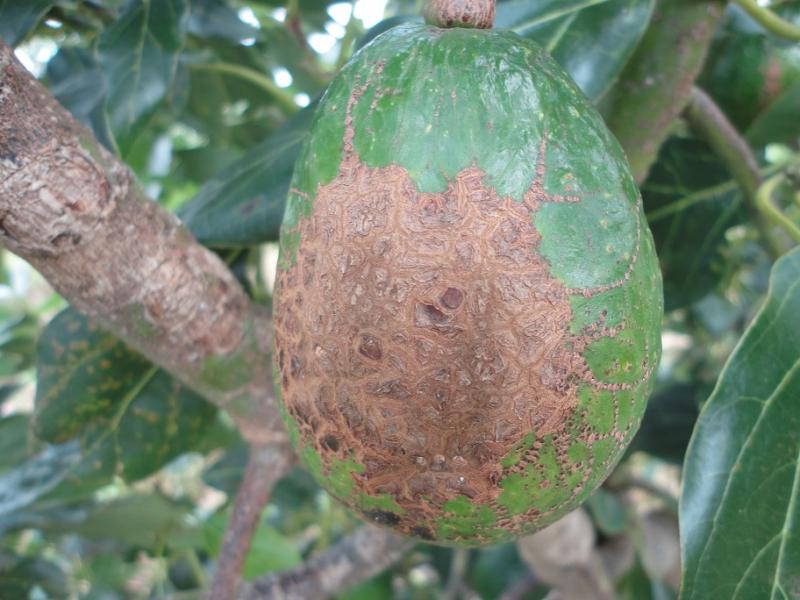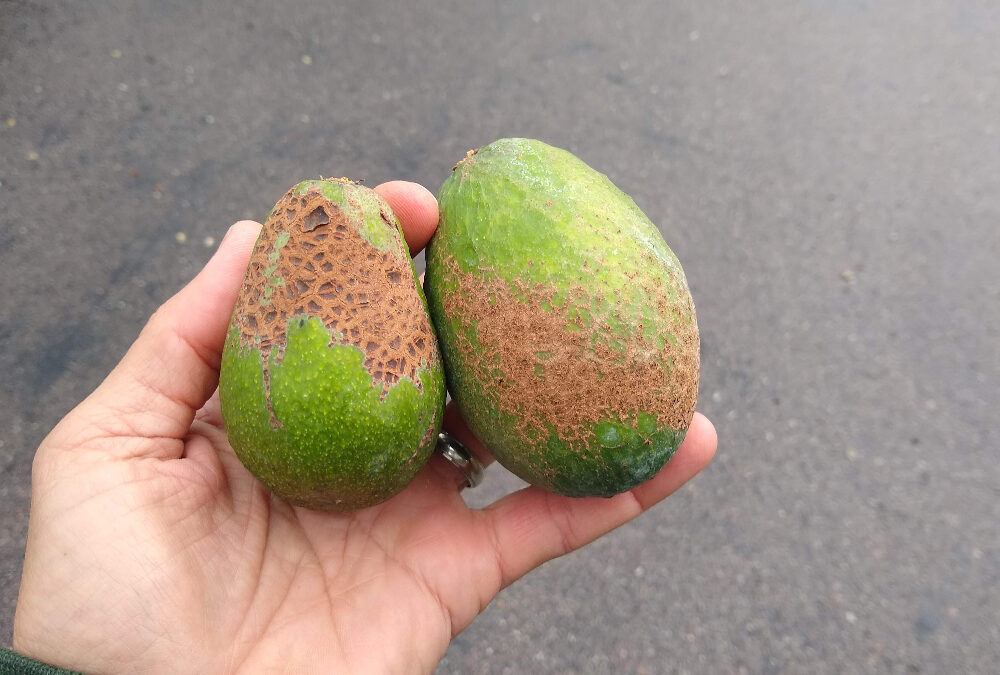
Thrips
Frankliniella Sp. / Scirtothrips Sp.
Pathogen:
Insect
Type:
Risk:
HIGH





DESCRIPTION
Pathogen description
Frankliniella sp. and Scirtothrips sp. They are tiny insects known as thrips that seriously affect the avocado crop. These insects go through several stages from egg to adult. The females deposit their eggs within the plant tissue, and after a few days, they hatch into larvae that go through two larval instars while they feed on the plant tissues, sucking its cellular contents. After completing larval development, the larvae fall to the ground or take refuge in the bark to enter the prepupal and pupal stages. Under optimal conditions, complete development from egg to adult can take about two weeks. Adults are mobile and disperse quickly in search of new host plants, spreading the infestation. Thrips reproduce prolifically, allowing several generations per year, which complicates their control in crops such as avocado.
Disease description
In avocado, thrips cause significant damage that affects both the appearance and quality of the fruit. Thrips suck sap from developing leaves, flowers and fruits, causing deformations and scars. Affected leaves may show silver or tan Taches and irregular growth. Severe infestation can lead to premature leaf and fruit drop, affecting the production and vigor of the tree.
- Silver or tan Taches on leaves
- Scars and deformations in the fruits
- Premature fall of leaves and fruits
- Irregular and stunted leaf growth
- Reduction in the quality and commercial value of the fruit
- Loss of general vigor of the tree

TEMPERATURE AND HUMIDITY
20-30°C
60-80%

VOIES DE TRANSMISSION
Wind, Infected plants, Contaminated tools, Vector insects, Direct contact between plants, Transport of fruits and plant material

Chemical treatments
CONTROL
• RAPE OIL 1.53% [AL] P/V
• RAPE OIL 848.24 g/l [EC] P/V
• ORANGE OIL 6% [SL] P/V
• ORANGE OIL 60g/L [ME] P/S
• PARAFFIN OIL (CAS [64742-46-7]) 79% [EC] P/V
• PARAFFIN OIL (CAS [8042-47-5]) 54.6% [EW] P/V
• AZADIRACTIN 1% (AS AZADIRACTIN A) [EC] P/V
• Azadirachtin 2.6% (AS AZADIRACTIN A) [EC] P/V
• DELTAMETHRIN 2.5% [EC] P/V
• LAMBDA CYHALOTHRIN 10% [CS] P/V
• PYRETHRINS 4.65% (as pyrethrum extract) [EC] P/V
• POTASSIUM SALTS OF FATTY ACIDS C14-C20 48% [EW] P/V
• SPINETORAM 25% [WG] P/P
• TAU-FLUVALINATE 24% [EW] P/V
• ADHESIVE TRAP
• CHROMATIC TRAP
Treatments authorized in organic farming
• RAPE OIL 1.53% [AL] P/V
• RAPE OIL 848.24 g/l [EC] P/V
• ORANGE OIL 6% [SL] P/V
• ORANGE OIL 60g/L [ME] P/S
• PARAFFIN OIL (CAS [64742-46-7]) 79% [EC] P/V
• PARAFFIN OIL (CAS [8042-47-5]) 54.6% [EW] P/V
• AZADIRACTIN 1% (AS AZADIRACTIN A) [EC] P/V
• Azadirachtin 2.6% (AS AZADIRACTIN A) [EC] P/V
• LAMBDA CYHALOTHRIN 10% [CS] P/V
• PYRETHRINS 4.65% (as pyrethrum extract) [EC] P/V
• POTASSIUM SALTS OF FATTY ACIDS C14-C20 48% [EW] P/V
• ADHESIVE TRAP
• CHROMATIC TRAP
Biological control
• AMBLYDROMALUS LIMONICUS (Parasitoid and predatory mites)
• AMBLYSEIUS SWIRSKII (Parasitoid and predatory mites)
• BEAUVERIA BASSIANA (STRAIN ATCC 74040) 2.3% (2.3X10E7 VIABLE SPORES/ML) [OD] P/V
• BEAUVERIA BASSIANA (GHA STRAIN) 22% (4.4 x 10E10 CONIDIAS/G) [WP] P/P
• BEAUVERIA BASSIANA strain PPRI 5339 8% (8 X 10E12 CFU/L) [OD] P/P
• CHRYSOPERLA CARNEA (Parasitoid and predatory insects)
• HETERORHABDITIS BACTERIOPHORA (Parasitoid and predatory nematodes)
• MACROCHELES ROBUSTULUS (Parasitoid and predatory mites)
• MACROLOPHUS PYGMAEUS (Parasitoid and predatory insects)
• METARHIZIUM BRUNNEUM strain Ma 43 10.5% [OD] P/V
• NEOSEIULUS CUCUMERIS (Parasitoid and predatory mites)
• ORIUS LAEVIGATUS (Parasitoid and predatory insects)
• PAECILOMYCES FUMOSOROSEUS (STRAIN FE 9901) 18% (2 X 10 E9 CFU/G) [WP] P/P
• STEINERNEMA FELTIAE (Parasitoid and predatory nematodes)
• TRANSEIUS MONTDORIENSIS (Parasitoid and predatory mites)
Preventive treatments
• BEAUVERIA BASSIANA (STRAIN ATCC 74040) 2.3% (2.3X10E7 VIABLE SPORES/ML) [OD] P/V
• BEAUVERIA BASSIANA (GHA STRAIN) 22% (4.4 x 10E10 CONIDIAS/G) [WP] P/P
• BEAUVERIA BASSIANA strain PPRI 5339 8% (8 X 10E12 CFU/L) [OD] P/P
• ADHESIVE TRAP
• CHROMATIC TRAP
- Carry out frequent monitoring of the crop to detect the presence of thrips in early stages.
- Use blue sticky traps to monitor and reduce the adult population.
- Implement integrated pest management (IPM) practices, combining biological, cultural and chemical methods.
- Promote the presence of natural enemies such as predatory mites and lacewings, which help control thrips populations.
- Avoid excessive use of broad-spectrum insecticides that can affect natural enemies.
- Apply specific chemical treatments in rotation to prevent the development of resistance.
- Maintain good health in the garden, eliminating plant debris and weeds that can serve as a refuge for thrips.
- Ensure proper nutrition and irrigation of trees to keep them vigorous and less susceptible to infestations.
Recommendations
*The recommended treatments are recommendations based on the authorities' databases and do not replace in any way the guidelines established by the legislation of each country.





